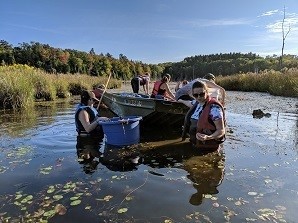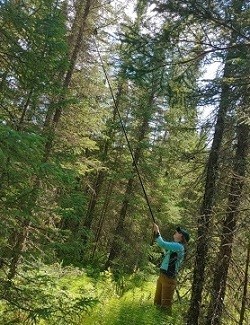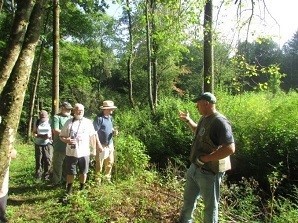DEC and SUNY Cobleskill Students Team up to Combat Invasive Species
 This past September, DEC Region 4 Ecologist Steve Swenson and SUNY Cobleskill’s student chapter of the Society for Conservation Biology (SCB) hosted the 2nd annual invasive water chestnut clean up at Looking Glass Pond in Schoharie County. The crew had a successful evening pulling two truckloads of invasive water chestnut from the pond. DEC and students will likely remove more plants in May of 2020 before the students leave for the summer and before seeds develop. This past September, DEC Region 4 Ecologist Steve Swenson and SUNY Cobleskill’s student chapter of the Society for Conservation Biology (SCB) hosted the 2nd annual invasive water chestnut clean up at Looking Glass Pond in Schoharie County. The crew had a successful evening pulling two truckloads of invasive water chestnut from the pond. DEC and students will likely remove more plants in May of 2020 before the students leave for the summer and before seeds develop.
When the water chestnut infestation in Looking Glass Pond was first brought to DEC’s attention in the spring of 2017, it was quite small and able to be pulled by a few staff. However, in 2018 it expanded, and staff pulled four truckloads. Hopefully, the decrease to two truckloads in 2019 is a sign of water chestnut suppression at this pond.
Prevention is the best method to keep water chestnut from spreading! Some ways to help include:
- Clean, drain, and dry your watercraft, trailer, and equipment before and after each use.
- Flush the inside of the motor and all compartments with hot water (140°F) for two minutes.
- Dump bait bucket water where it came from or on land.
- If you think you've found water chestnut please take several photos and submit a report to iMapInvasives.
Photo by Carmen Greenwood.
DEC’s Spruce Grouse Recovery Efforts
 DEC Wildlife Staff is involved in a spruce grouse translocation project to help boost numbers of the state-endangered spruce grouse and to improve genetic diversity of the remaining population in New York. To meet the goal of maintaining their population in NY over the next 100 years, DEC will need to release 250 adult individuals from outside populations into NY over the next five years and manage habitat at several sites. To meet the translocation objective, staff released 34 adult spruce grouse and 71 young in 2018 and 50 adults and 111 young in 2019. Staff have been maintaining locations on grouse using radio telemetry at least once per week since grouse were released this past August. After release, spruce grouse have been observed moving within and between lowland boreal forests (their habitat). They have also been observed “flocking up” with resident spruce grouse, a behavior that resident NY spruce grouse also do in the fall. DEC Wildlife Staff is involved in a spruce grouse translocation project to help boost numbers of the state-endangered spruce grouse and to improve genetic diversity of the remaining population in New York. To meet the goal of maintaining their population in NY over the next 100 years, DEC will need to release 250 adult individuals from outside populations into NY over the next five years and manage habitat at several sites. To meet the translocation objective, staff released 34 adult spruce grouse and 71 young in 2018 and 50 adults and 111 young in 2019. Staff have been maintaining locations on grouse using radio telemetry at least once per week since grouse were released this past August. After release, spruce grouse have been observed moving within and between lowland boreal forests (their habitat). They have also been observed “flocking up” with resident spruce grouse, a behavior that resident NY spruce grouse also do in the fall.
 Most of the females released in 2018 that survived until the 2019 breeding season attempted to nest and some even reared young in 2019! Approximately half of released grouse live to breed the following year, which is slightly below the average for resident grouse. Most of the females released in 2018 that survived until the 2019 breeding season attempted to nest and some even reared young in 2019! Approximately half of released grouse live to breed the following year, which is slightly below the average for resident grouse.
DEC urges folks to be aware of the presence of spruce grouse in the northern Adirondacks when driving on dirt roads from as far west as Cranberry Lake to as far east as Bloomingdale. Spruce grouse can congregate in small numbers on roads to eat gravel and may be mistaken for ruffed grouse during the hunting season.
For more information check out the Spruce Grouse Recovery Plan or send us an e-mail.
Photos by Angelena Ross - researcher capturing a spruce grouse and grouse in transit.
DEC Staff Gives Guided Walk at Tioughnioga Wildlife Management Area
 Region 7 Wildlife Biologist Adam Perry hiked through Tioughnioga Wildlife Management Area (WMA) in Madison County with members of the North Country Trail Association: Central New York Chapter, Ruffed Grouse Society, and other partners. The August 2019 outing followed a section of trail that is immediately adjacent to recent habitat management done as part of the Young Forest Initiative (YFI). They also visited sites with restored grassland habitat. Adam discussed the YFI and described why certain management activities increase young forest habitat for species specific to Tioughnioga WMA, including wild turkey and songbirds, such as Canada warbler and wood thrush. Region 7 Wildlife Biologist Adam Perry hiked through Tioughnioga Wildlife Management Area (WMA) in Madison County with members of the North Country Trail Association: Central New York Chapter, Ruffed Grouse Society, and other partners. The August 2019 outing followed a section of trail that is immediately adjacent to recent habitat management done as part of the Young Forest Initiative (YFI). They also visited sites with restored grassland habitat. Adam discussed the YFI and described why certain management activities increase young forest habitat for species specific to Tioughnioga WMA, including wild turkey and songbirds, such as Canada warbler and wood thrush.
Young forest refers to an early stage of forest with tree seedlings, saplings, woody vines, shrubs, grasses, and flowering plants growing together. Young forests are approximately 0-10 years old. Historically, young forests were created by natural disturbances such as:
- fire or flooding
- insect outbreaks
- changes to the landscape by beavers
- human activities, such as logging and farmland abandonment
Today, active land management is required to maintain young forests throughout New York's landscape.
Photo by Larry Ferris.
|


 This past September, DEC Region 4 Ecologist Steve Swenson and SUNY Cobleskill’s student chapter of the Society for Conservation Biology (SCB) hosted the 2nd annual invasive water chestnut clean up at Looking Glass Pond in Schoharie County. The crew had a successful evening pulling two truckloads of invasive
This past September, DEC Region 4 Ecologist Steve Swenson and SUNY Cobleskill’s student chapter of the Society for Conservation Biology (SCB) hosted the 2nd annual invasive water chestnut clean up at Looking Glass Pond in Schoharie County. The crew had a successful evening pulling two truckloads of invasive  DEC Wildlife Staff is involved in a
DEC Wildlife Staff is involved in a  Most of the females released in 2018 that survived until the 2019 breeding season attempted to nest and some even reared young in 2019! Approximately half of released grouse live to breed the following year, which is slightly below the average for resident grouse.
Most of the females released in 2018 that survived until the 2019 breeding season attempted to nest and some even reared young in 2019! Approximately half of released grouse live to breed the following year, which is slightly below the average for resident grouse. Region 7 Wildlife Biologist Adam Perry hiked through Tioughnioga Wildlife Management Area (WMA) in Madison County with members of the North Country Trail Association: Central New York Chapter, Ruffed Grouse Society, and other partners. The August 2019 outing followed a section of trail that is immediately adjacent to recent habitat management done as part of the Young Forest Initiative (YFI). They also visited sites with restored grassland habitat. Adam discussed the YFI and described why certain management activities increase young forest habitat for species specific to Tioughnioga WMA, including wild turkey and songbirds, such as Canada warbler and wood thrush.
Region 7 Wildlife Biologist Adam Perry hiked through Tioughnioga Wildlife Management Area (WMA) in Madison County with members of the North Country Trail Association: Central New York Chapter, Ruffed Grouse Society, and other partners. The August 2019 outing followed a section of trail that is immediately adjacent to recent habitat management done as part of the Young Forest Initiative (YFI). They also visited sites with restored grassland habitat. Adam discussed the YFI and described why certain management activities increase young forest habitat for species specific to Tioughnioga WMA, including wild turkey and songbirds, such as Canada warbler and wood thrush.